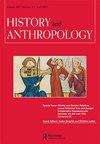这艘船
IF 0.4
2区 历史学
Q3 ANTHROPOLOGY
引用次数: 0
摘要
2021年3月,世界上最大的集装箱船之一“Ever Given”号在苏伊士运河搁浅并堵塞了6天,这一事件极大地揭示了全球贸易对海上基础设施的脆弱依赖。它还提请人们注意船舶在这个全球流动系统中的作用。在这篇文章中,我以船的形象为中心,反思海上通道和阻塞,以及通过它们出现的特殊社会形式。从集装箱船上的民族志中,我探索了船员如何与各种角色互动,如当局,飞行员,船夫和小贩,他们有时促进,有时阻碍,船只的通道。通过这个民族志的镜头,我看到了流动与静止、流动与摩擦、联系与孤立的交叉动态,这些动态渗透在苏伊士运河和当代海洋中,塑造了船上和周围的社会世界。本文章由计算机程序翻译,如有差异,请以英文原文为准。
The ship
ABSTRACT When Ever Given, one of the world’s largest container ships, ran aground and blocked the Suez Canal for six days in March 2021, it dramatically brought to light the fragile dependency of global trade on maritime infrastructures. It also drew attention to ships as actors within this global system of mobility. In this article, I centre on the figure of the ship to reflect on maritime passages and blockages and the particular forms of sociality that emerge through them. Drawing on ethnography from onboard container ships, I explore how crews interact with various actors, such as authorities, pilots, boatmen and peddlers, who, at times facilitate, at times obstruct, ships’ passages. Through this ethnographic lens, I make visible the intersecting dynamics of mobility and immobility, flow and friction, and connection and isolation that permeate the Suez Canal and the contemporary maritime, and which shape the social worlds on and around ships.
求助全文
通过发布文献求助,成功后即可免费获取论文全文。
去求助
来源期刊

History and Anthropology
Multiple-
CiteScore
1.80
自引率
0.00%
发文量
41
期刊介绍:
History and Anthropology continues to address the intersection of history and social sciences, focusing on the interchange between anthropologically-informed history, historically-informed anthropology and the history of ethnographic and anthropological representation. It is now widely perceived that the formerly dominant ahistorical perspectives within anthropology severely restricted interpretation and analysis. Much recent work has therefore been concerned with social change and colonial history and the traditional problems such as symbolism, have been rethought in historical terms. History and Anthropology publishes articles which develop these concerns, and is particularly interested in linking new substantive analyses with critical perspectives on anthropological discourse.
 求助内容:
求助内容: 应助结果提醒方式:
应助结果提醒方式:


